![]()
Follow the links. You'll learn a lot!
As best I can put the pieces together, my grandfather Jan (John) Pacuta (a "makcen" over the "c" gave it a "ch" sound which accounts for the current spelling) came to the States in 1900. His brother Pavel (Paul) also emigrated to the United States, but did not arrive until 1914. Their father (my great-grandfather) was also named Pavel. Their mother (my great-grandmother) was named Anna Tkacova Pacutova. (My uncle says that the elder Pavel had a "family feud" with a brother in Slovakia. The two parted ways and never saw each other again.) My great-great-grandparents were named Petro Pacuta and Anna Bartkova Pacutova.
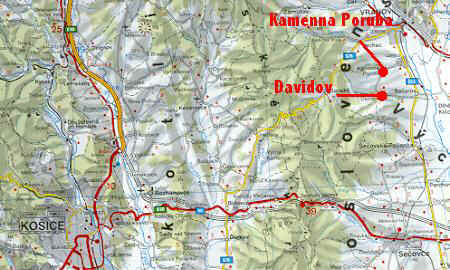 My grandfather was born in Kamenna
Poruba, but spoke to his family about Davidov, a small village nearby. This
was probably because he purchased a farm there in the early 1900s and
planned to return to Slovakia to live on that farm. Both are about 20
miles northeast of Kosice in the Carpatho-Ruthenian region
of eastern Slovakia which has a mixture of cultures. Michael Sura, a
genealogist from Kosice, has contacted this site with information about
the Rusyn people. His insights add a different perspective to our heritage.
My grandfather was born in Kamenna
Poruba, but spoke to his family about Davidov, a small village nearby. This
was probably because he purchased a farm there in the early 1900s and
planned to return to Slovakia to live on that farm. Both are about 20
miles northeast of Kosice in the Carpatho-Ruthenian region
of eastern Slovakia which has a mixture of cultures. Michael Sura, a
genealogist from Kosice, has contacted this site with information about
the Rusyn people. His insights add a different perspective to our heritage.
The Rusyn culture
Similar to the way
in which various ethnic groups become Americans when they come to the
United States, some Rusyns are now Slovaks. The Rusyns' historical
homeland comprises parts of eastern Slovakia, western Ukraine, and
southeastern Poland. Rusyns are predominantly Greek Catholic and have
their own culture and language.
Our surname, Pachuta, is typical of Rusyn names. Therefore, our branch of
the family is Slovak but of Rusyn descent. The Rusyn language was spoken
in the region 200 years ago, but has largely disappeared. Some of the
words used in the region around Kamenna Poruba and Davidov have Rusyn
roots. I've visited both
villages. 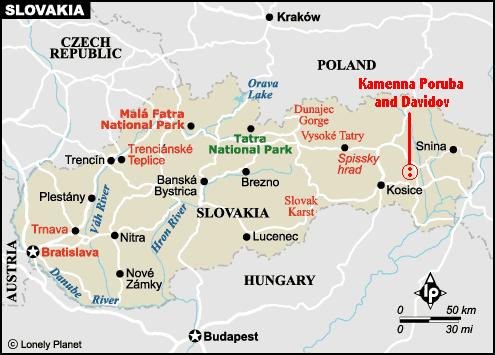 The story with photos is part of this site. In addition
to Slovak, my father recalled that my grandfather was able to speak
Russian, Polish, and some Hungarian. While the first three are Slavic
languages with common words and structures, Hungarian is distinctly
different. The uniqueness of that language
was discussed by an individual who contacted this website.
The story with photos is part of this site. In addition
to Slovak, my father recalled that my grandfather was able to speak
Russian, Polish, and some Hungarian. While the first three are Slavic
languages with common words and structures, Hungarian is distinctly
different. The uniqueness of that language
was discussed by an individual who contacted this website.
The Pachuta name is now found in six different Eastern European nations. In addition to the three that are part of the Rusyn homeland, many Pachutas are in the Czech Republic, Russia and Hungary.
My grandfather's family
When my grandfather came to the States, he left behind his parents, two sisters, Anna and Maria, his brother, and other relatives. Another sister had died at a very young age. My grandfather was the eldest sibling (born on January 3, 1882). Anna was born in 1888. Pavel was born in 1892, and Maria was born in 1898. Anna married Jan Antus in Vranov. My Aunt Julie has a letter from my grandfather's sister with the address "Kamenna Poruba, p.p. Cemerne okr Vranov." Vranov is a larger city north of Davidov. Cemerne is southwest of the city across the Topla River. Helena Antusova, Jan and Anna's daughter-in-law, now lives in the house where my grandfather was raised in Kamenna Poruba. Maria married into the Bartko family.
Emigrating to America
My grandfather booked passage on a ship which was promoted by a
transatlantic shipping agent named Friedrich
Missler in Bremen, Germany. Bremen was the most popular port of embarkation for Eastern European
emigrants. A search of the Ellis
Island website shows several immigrants named "Janos Pacsuta."
(Pacsuta is
the
Hungarian version of our surname and it is how the name appeared on my
grandfather's passport. Janos is the Hungarian version of Jan.) The
 listing which is the closest match to my grandfather has an arrival date in the US
of November 11, 1900 aboard the
S.S. Prinzregent Luitpold from Bremen. His age was listed as 17 and his home was listed as "Czeko,
Hungary."
listing which is the closest match to my grandfather has an arrival date in the US
of November 11, 1900 aboard the
S.S. Prinzregent Luitpold from Bremen. His age was listed as 17 and his home was listed as "Czeko,
Hungary."
Since Slovakia was part of Austria-Hungary, all Slovak cities and towns were considered to be Hungarian. The term "Czeko" was frequently used as a reference for what later became Czechoslovakia. His profession was "laborer," and his final destination was "Philipsburg," a city in the coal region of Pennsylvania. According to the manifest, he paid for the ticket himself and had $8 in his pocket. While I can't be certain this entry refers to my grandfather, it best fits the information that I have.
A footnote: Another record for a "Janos Pacsuta" has him arriving on October 19,1900 aboard the S.S. Aller at the age of 18, also from "Czeko, Hungary." While the age is a better match, the manifest says that that Janos would be living with his brother in Morristown, New Jersey. Many Pachutas live in the Trenton area. It is probably one of that family's ancestors.
Another interesting footnote: I also found the manifest of the S.S. Bremen which left Germany on April 7, 1900, arriving in New York on April 16, 1900. On board were Mihaly Pacsuta (age 25), Jozsef Bartko (age 38), and Mihaly Tkac (age 25). Their names are together on the manifest and Kamenna Poruba is listed as the home for all three. All of them were on their way to the same area of Pennsylvania, Cambria County, to stay with Mihaly's brother, Janos Tkac. It says that Joszef Bartko was married and had lived in the US before for eight years. The other two men were single. Since I am related to Tkacs and Bartkos, I believe these men were all somehow related to our family. Joan Pipich, whose husband had Pacuta ancestors, has recently added insight into what happened in Cambria County.
My grandfather had served in the Austro-Hungarian army and (based upon my aunt’s recollections) took care of the horses for one of the cavalry units. My aunt has his military papers. He was considered, by Austro-Hungarian officials, to be available for military service right up to the start of World War I.
Living in Pennsylvania
In the US, he took a train to Pennsylvania where he stayed with
relatives. He worked the coke ovens near Uniontown which he described to his
family as "hot and hard work." He said that he
and an older relative with
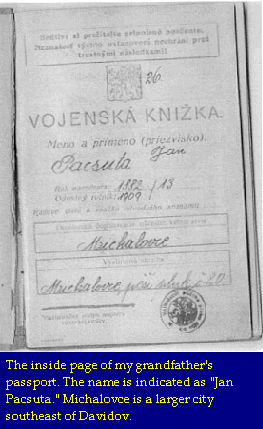 whom he worked had the same name. The two of
them told everyone that they were father and son even though they were
not. The Ellis Island
site contains the record of another "Janos Pacsuta" of "Kamenna
Poruba, Hungary" who arrived in the States on August 23, 1898. He was
29 years old and on his way to Mt. Carmel in Allegheny County, Pennsylvania.
That Janos had first come to the States in 1887. This could have been the relative that my grandfather
described. Immigration records indicate that the older Janos traveled back and
forth between the US and Slovakia several times in the early 1900s. Allegheny County is in the Pittsburgh area. Several
Uniontowns are in Pennslyvania, but the largest city with that name is
south of Pittsburgh about half-way to the West Virginia state line.
whom he worked had the same name. The two of
them told everyone that they were father and son even though they were
not. The Ellis Island
site contains the record of another "Janos Pacsuta" of "Kamenna
Poruba, Hungary" who arrived in the States on August 23, 1898. He was
29 years old and on his way to Mt. Carmel in Allegheny County, Pennsylvania.
That Janos had first come to the States in 1887. This could have been the relative that my grandfather
described. Immigration records indicate that the older Janos traveled back and
forth between the US and Slovakia several times in the early 1900s. Allegheny County is in the Pittsburgh area. Several
Uniontowns are in Pennslyvania, but the largest city with that name is
south of Pittsburgh about half-way to the West Virginia state line.
My grandfather's goal was to earn enough money to purchase a farm in Davidov. He did just that. My father remembered that my grandfather described it as being 30 acres in size (very large by Slovak standards) and located on the bend of a river - one of the best pieces of property in Davidov. My grandfather may have actually returned to Slovakia to make the purchase, although I have found no record of the trip.
Moving to Ohio
Sometime before 1906, my grandfather moved to Ohio. Upon arriving there, he was greeted by other Pachuta relatives who had emigrated to America before he did. One cousin (also named John) was in Robins, Ohio (formerly called Trail Run). That "John" has many descendents who have contacted The Pachuta Page. My grandfather met Julka (Julia) Kolackovsky (Kolasky) in Ohio and married her on February 12, 1906. He was 24 years old and she was 17 (having been born on April 8, 1888). Her family was from Abouska Ruskov, Slovakia. The newlyweds must have lived in Robins for a time because their first child, Paul (my Uncle Farmer), was born in Robins on April 2, 1908. Relatives from the Kolasky family have also contacted this website.
Connections with Slovakia
In 1910, my grandfather visited his family and his farm in Davidov. His sister Maria's family stayed on the farm rent-free as caretakers. Because he was gone from the States for longer than expected, my pregnant grandmother and their son, Paul, (lots of Pauls in this family) booked passage to Slovakia to find out what was delaying him. My father's oldest sister, Mary (my Aunt Mack), was born on a ship in the Atlantic Ocean enroute from New York to Europe. Her birth was recorded in Vranov as November 10, 1910.
With the tumult of the First World War, Europe was in a state of upheaval. My grandfather allowed his sister's family to continue maintaining the property until the situation became more stable. His brother Pavel (Paul) emigrated to the States in 1914, about the time the war started. I suspect he may have accompanied my grandfather as he returned from a visit to Slovakia. The farm was sold just before Hitler marched into Czechoslovakia at the start of the Second World War. My grandfather had also purchased land in Canada which was sold at about the same time.
Life in Black Top
Also around
1914, the family moved to Black Top Mine, Ohio, where my
grandfather opened a pool hall and store for the miners. The mine was owned by the Akron Coal
Company, and was one of a large
number in the area that extracted coal from the Cambridge Coal Field, one
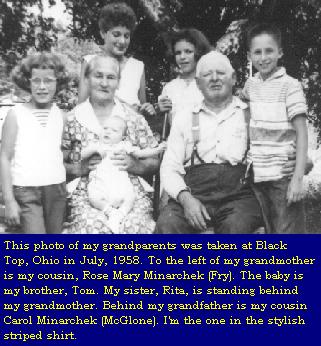 of
the richest veins of number nine coal in the nation. A photo
of the pool hall and the valley with the mine is on this site.
of
the richest veins of number nine coal in the nation. A photo
of the pool hall and the valley with the mine is on this site.
The family continued to grow. My
father, John, was born on January 18, 1916 in Black Top. In all, my grandparents had
11 children, but three died at birth.
 The three infants are buried in small graves in
Robins. On their tombstones, the last name was originally spelled "Pacsuta." Since then, a new tombstone has been placed
there (my Aunt Mack paid for it) with the names of all three and the spelling was changed to Pachuta.
Another son died in the great flu epidemic of
1918 which killed millions of people around the world. The seven children who lived were named Paul, Mary (married name –
Tomsho), John (my dad), Joseph (Herb - born November 5, 1919), Anna (married name – Minarchek,
born October 16, 1921), Andrew (Bill - born July 6, 1923) and Julia (born April 12,
1927).
The three infants are buried in small graves in
Robins. On their tombstones, the last name was originally spelled "Pacsuta." Since then, a new tombstone has been placed
there (my Aunt Mack paid for it) with the names of all three and the spelling was changed to Pachuta.
Another son died in the great flu epidemic of
1918 which killed millions of people around the world. The seven children who lived were named Paul, Mary (married name –
Tomsho), John (my dad), Joseph (Herb - born November 5, 1919), Anna (married name – Minarchek,
born October 16, 1921), Andrew (Bill - born July 6, 1923) and Julia (born April 12,
1927).
My father recalled that relatives from Canada visited Black Top during the 1920s. In searching the Internet, I've found several "Pacsuta" families who live in Canada. It's very likely that we have relatives who never changed the spelling of their surnames from the Hungarian version. Some Pacsutas also live in Ohio.
My great uncle Paul visited the family in Slovakia in 1922. The Ellis Island website has a record of his return to New York on January 26, 1923. (The name on the manifest is Pavel Pacuta.) It says that he had been a resident of the US from 1914 to 1921 and would be staying with his brother, "John Pacuta" in "Black Top Mine (Cambridge, Ohio), Lore City, RFD3." His age was listed as 31 and it indicates he was married with a home city of "Poruba, Czechoslovakia." It describes him as 5' 8" with brown hair and brown eyes. The ship was named the S.S. Rotterdam and embarked from Boulogne Sur Mer, Pas-de-Calais, France. He paid for the passage himself and had $100 with him.
My grandfather was crippled in the
early 1930s. Though the story sounds strange, his incapacity resulted from drinking
a bad batch of a medicinal product called Jamaica Ginger. During
Prohibition, alcohol was, of course, illegal. Because of this, the miners
would legally purchase the Jamaica Ginger, which had an alcoholic content.
My grandfather kept a supply at the pool hall. One batch of the product had apparently been laced with wood alcohol,
causing many of the miners to come down with paralysis. Almost all of the
miners recovered, but, sadly, my grandfather did not.
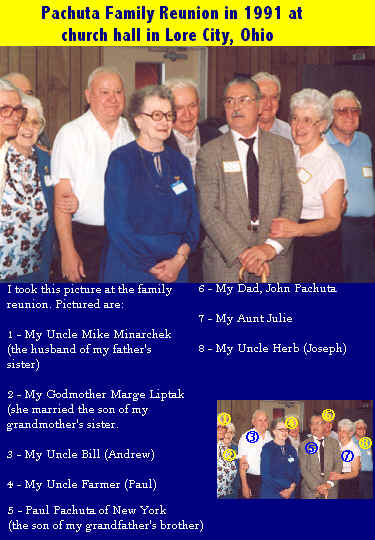 My father told me that many
people in the valley suspected that "the feds" had done this
on purpose as a lesson to the miners.
My father told me that many
people in the valley suspected that "the feds" had done this
on purpose as a lesson to the miners.
Because of this, my father never finished high school. Instead, he went to work in the mines at the age of 16 to help support the family. The miners went on strike in the early '30s and the mine was shut down. The family did whatever it could to make ends meet.
Relatives around the world
My Uncle Farmer (Paul) moved to Weirton, West Virginia, where he became an electrician at Weirton Steel. He helped support the family by religiously sending a portion of every paycheck back to Black Top. With the Great Depression in full force, my father moved between Canton and Lore City, Ohio, to find work.
The family of my great uncle Paul (my grandfather's brother) settled in New York state. He and his wife had two sons, Paul and John, and two daughters, Anna and Maria. That Paul (it's difficult to keep all of these Pauls straight), became a glass and crystal cutter with a very exclusive clientele. He, in turn, had two sons, Paul and Eddie. John's son, Rich, lives in New Jersey. Two of them have communicated with me and can be contacted by clicking on the map of New York on The Pachuta Page.
Many Pachutas now live in New York and New Jersey. I met one of Paul’s descendants, Chris. We shared family information in New York City in August of 2000 and put a few more leaves on the family tree. Since then, more of my first cousins (from the Minarchek family) have visited Chris and his wife, Cecilia.
My great uncle Paul's family visited Slovakia frequently. As a result, his four children were born both in the US and in Slovakia. I met his daughter (and my second cousin), Maria Lacna, when I was in Slovakia. She lives in Sacurov, near Davidov and Kamenna Poruba. When the Second World War approached, US immigration standards stiffened. Even though his sons had been born in America and were American citizens, Paul never become a naturalized citizen. When he attempted to re-enter the States after a trip to Slovakia, he was denied entry and had to return to Slovakia where he lived out his life.
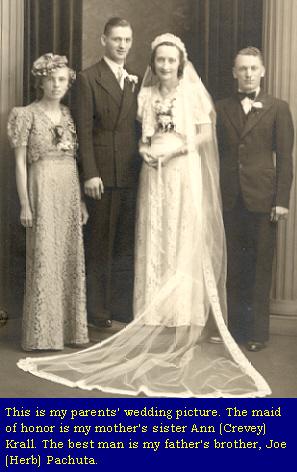 Weddings,
births and funerals
Weddings,
births and funerals
On October 5, 1940, my father married my mother, Margaret Crevey (Krivi) at SS. Peter and Paul’s Catholic Church in Lore City. They had met in high school and, because my father’s family couldn’t afford school books, he’d borrow my mother’s books to study.
My grandfather died at Black Top in 1971 at the age of 89. My grandmother died in 1980 at the age of 92. They are buried in the cemetery at SS. Peter and Paul.
I've also searched the Ellis Island site for my maternal grandfather, and believe I've found a record of his arrival in New York. On October 15, 1901, Istven Krivi (my grandfather Americanized his name to "Steve Crevey") arrived on the S.S. Kaiser Wilhelm der Grosse, which had left Bremen seven days earlier.
The ship's manifest says that his passage was paid by a cousin
and that he was 19 years old. He had $2 in cash and would be
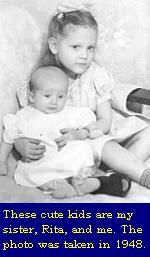 living with a
cousin in Ohio. He was listed as being from Hungary with a Slovak
nationality. The village of Padojelava (as best I can read the writing) was
named as his home. My mother's father never knew his real birthday because
accurate records weren't kept in Slovakia, so he considered October 15 to be
his birthday. Information from my mother and the coincidence of the arrival
date and the birthday make me feel that the arrival record is his. I
have the pocket watch he purchased when he arrived in New York City. It's
been reconditioned and operates as good as new - one of my prized
possessions.
living with a
cousin in Ohio. He was listed as being from Hungary with a Slovak
nationality. The village of Padojelava (as best I can read the writing) was
named as his home. My mother's father never knew his real birthday because
accurate records weren't kept in Slovakia, so he considered October 15 to be
his birthday. Information from my mother and the coincidence of the arrival
date and the birthday make me feel that the arrival record is his. I
have the pocket watch he purchased when he arrived in New York City. It's
been reconditioned and operates as good as new - one of my prized
possessions.
In 1907, he married Anna Mazenko, the oldest of 13 children, in Lore City. My mother was the youngest of three children. Her older sister was named Ann Rita. Her brother was named Michael Angelo (Mick). Ann's first husband, Joe Krall, was killed in a coal mining accident in the 1930s. Her second husband was Michael (Mickey) Regan. She had one son, also named Joe Krall. My uncle Mick married Mary Day. They had no children.
I was born (at
home) in Lore City, on December 29, 1947 - too late for Christmas, but in
time for a tax deduction. Although I have always been called Jack, my name
is "John Joseph" Pachuta. My older sister, Rita, was born in 1943 in
Canton. My
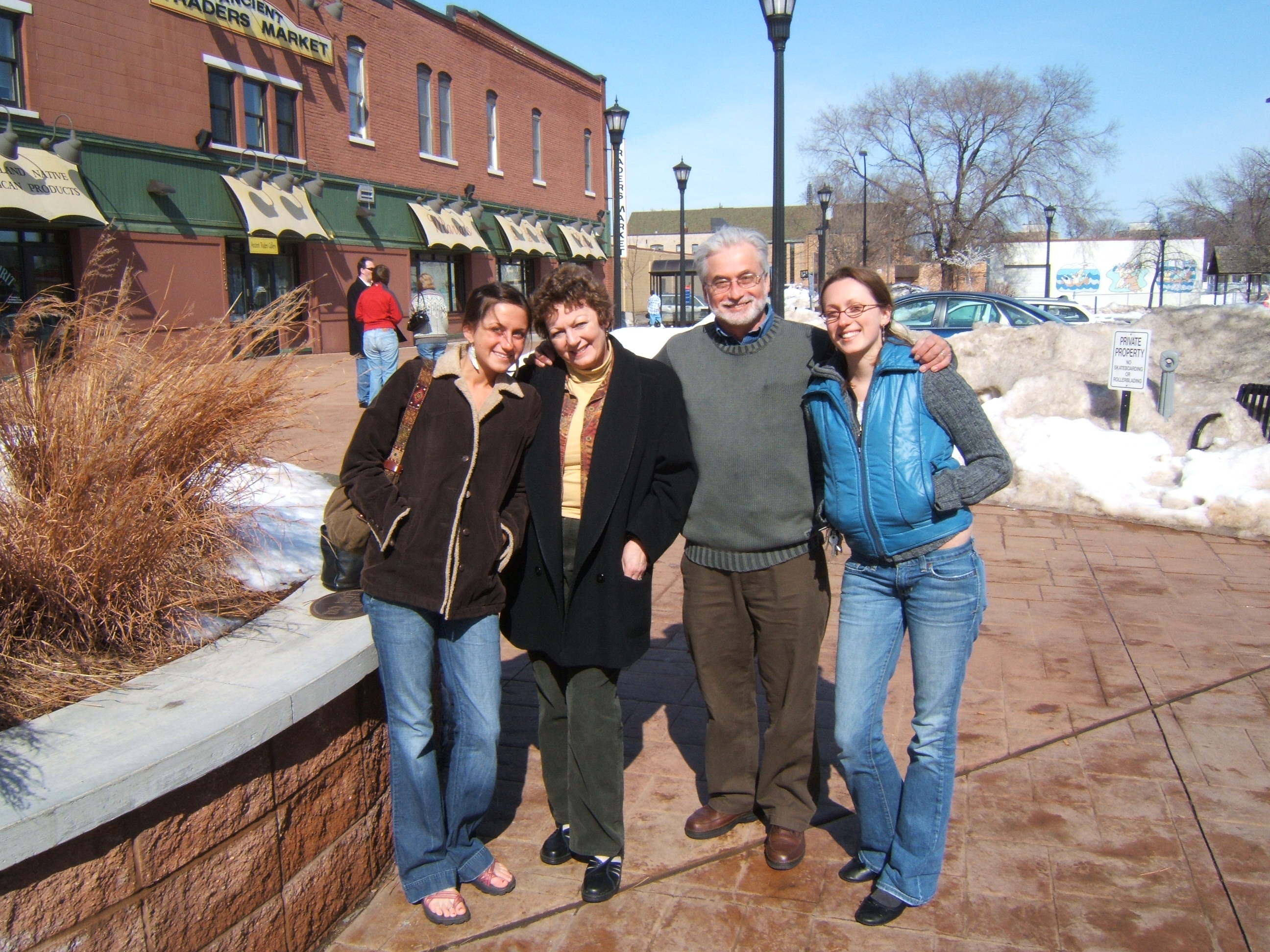 younger
brother, Tom, was also born in Canton in 1958. My father died on June 13,
1994. My mother died in Canton on June 11, 2005. Both are buried in
Calvary Cemetery in Massillon, Ohio.
younger
brother, Tom, was also born in Canton in 1958. My father died on June 13,
1994. My mother died in Canton on June 11, 2005. Both are buried in
Calvary Cemetery in Massillon, Ohio.
My wife, Renira, is English. We met in Portugal in 1974 and were married in 1976. Our two daughters are Emma (22) and Abby (19). The photo to the right was taken in January of this year in Minneapolis. Emma is a graduate of the University of Minnesota with a degree in architecture and is currently working at an architecture firm in St. Paul. Abby is a sophomore at the University, majoring in Environmental Studies. Renira is the community editor for the local newspaper, The News Graphic.
Since 1991, I have been a professional speaker. When 9/11 changed the world, my business also changed. Now, I consider myself an Internet marketer who speaks professionally. My main products relate to murder mystery events. You can find out more by visiting my many websites: www.mysteries-on-the-net.com, www.kids-mysteries.com, www.writeamystery.com, www.murdermysteryatsea.com and www.mystroku.com.
I am also an artist and a member of both the Cedarburg Artists Guild and the League of Milwaukee Artists. You can see some of my work at www.artbadger.com. Annually, Emma, Abby and I participate in the Plein Air Art Competition that is part of Strawberry Festival in Cedarburg. If you'd like to know more about me, you can look at my complete vita. Determine if you can see a family resemblance in this photo. I'm interested in your feedback.